Olmec religion

The religion of the Olmec people significantly influenced the social development and mythological world view of Mesoamerica. Scholars have seen echoes of Olmec supernatural in the subsequent religions and mythologies of nearly all later pre-Columbian era Mesoamericans cultures.
The first Mesoamerican civilization, the Olmecs, developed on present-day Mexico southern Gulf Coast in the centuries before 1200 BCE. The culture lasted until roughly 400 BCE, at which time their center of La Venta lay abandoned. The Olmec culture is often considered a "mother culture" to later Mesoamerican cultures.
There is no surviving direct account of the Olmec's religious beliefs, unlike the Maya, with their Popol Vuh, or the Aztecs, with their many codices and conquistador accounts.
Archaeologists, therefore, have had to rely on other techniques to reconstruct Olmec beliefs, most prominently:[1]

The religion of the Olmec people significantly influenced the social development and mythological world view of Mesoamerica. Scholars have seen echoes of Olmec supernatural in the subsequent religions and mythologies of nearly all later pre-Columbian era Mesoamericans cultures.
The first Mesoamerican civilization, the Olmecs, developed on present-day Mexico southern Gulf Coast in the centuries before 1200 BCE. The culture lasted until roughly 400 BCE, at which time their center of La Venta lay abandoned. The Olmec culture is often considered a "mother culture" to later Mesoamerican cultures.
There is no surviving direct account of the Olmec's religious beliefs, unlike the Maya, with their Popol Vuh, or the Aztecs, with their many codices and conquistador accounts.
Archaeologists, therefore, have had to rely on other techniques to reconstruct Olmec beliefs, most prominently:[1]
- Typological analysis of Olmec iconography and art.
- Comparison to later, better documented pre-Columbian cultures.
- Comparison to modern-day cultures of the indigenous peoples of the Americas.


No comments:
Post a Comment